Competition Day #2
Today (Sunday) includes the 15 km men’s sit-ski in the morning, and the women’s 10 km sit-ski in the afternoon. The women will do 3 x 3.3 km loops and the men 4 x 3.75 km loops.
Effectively sit-skiers have lost mobility of their lower body, however, because each skier may have a different disability there is a classification that is used to adjust times to “handicap” the skiers with more lower body strength for example. A sit-ski generally consists of an aluminum frame with a low seat; the frame clips into the bindings on regular cross country skis. Depending on whether the skier has had an amputation, has partial use of their legs, or their legs may have more paralysis, the legs and feet may be ahead of the skier or tucked under the seat. Skiers double pole the entire course; relatively speaking the physiology of poling and pole length is somewhat similar to an able bodied skier.
Just to get a feel for the challenges of double poling the entire course, I tried double poling one 3.75 km loop which includes several hills, a few good downhills and a couple of tight turns. With some effort I did double pole the course with the exception of about 6 metres on a longer uphill where I had to step out of the tracks to maintain momentum. Putting this into perspective the paranordic skiers are completing 3 or 4 loops, and in some cases they do this entirely with the upper body, and limited core strength. This is an incredible feat.
Forerunning today was as much ceremonial as anything. There was no new snow overnight and grooming produced two crisp tracks which were slightly glazed. What made things more interesting for the forerunners is that the course directors had asked that we not use hard wax or klister to avoid any residue in the tracks for the sit-skiers. This meant that the forerunners had to use hairies, eventhough conditions were more suitable for hard wax. By the end of the event I had made four passes of the trails.
The exciting part of the day is that the Canadian Team recruited forerunners to stand at the edge of the course to encourage/cheer Canadian Collette Bourgonge on in the women’s sit-ski. We spread out over about 500 metres of the trail and cheered Collette on for each lap. We would like to think that this extra encouragement helped Collette to claim the silver medal; and having met her on Saturday, the achievement could not happen to a better person.
The medals ceremony in Whistler was exciting as Canada claimed 3 silver medals.
Tomorrow is the women’s 10 km, and men’s 15 km freestyle. Canadian competitors included Brian and Robin Mckeever, Kanata’s own Alexi Novikov, and Mark Arandz, as well as Kanata’ Margarita Gourbonova, Jody Barber, and Robbie Weldon from Thunder Bay. There may be others but I am having a hard time finding a schedule.
The weather forecast calls for highs well above zero and a mix of snow and rain. We will skate and classic the 5 km course just before the start time. If it snows we will be assigned sections of the trail that we may need to ski in the classic track during the race, particularly if the classic is not well used.
Of course after we wrapped up after the race at about 1:30 this afternoon, three of us took advantage of the beautiful Callaghan Valley trails and skated for an hour and half or so. 80% of the time was spent climbing to the end of the trail. The return trip was about 20% of the time but represented the most fun as we dropped back into the Valley.
Also check out Margarita’s blog: http://paranordicskier.blogspot.com/
Mike.
